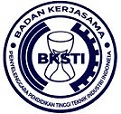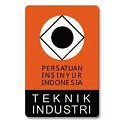Penerapan Lean Manufacturing di Sebuah Perusahaan Keramik
Abstract
Full Text:
PDFReferences
S. R. Shah and E. Naghi Ganji, “Lean production and supply chain innovation in baked foods supplier to improve performance,” Br. Food J., vol. 119, no. 11, pp. 2421–2447, 2017, doi: 10.1108/BFJ-03-2017-0122.
S. Nallusamy and M. A. Adil Ahamed, “Implementation of lean tools in an automotive industry for productivity enhancement - A case study,” Int. J. Eng. Res. Africa, vol. 29, no. March, pp. 175–185, 2017, doi: 10.4028/www.scientific.net/JERA.29.175.
Yadrifil, R. A. Pratama, and A. M. M. Rus, “Improvement recommendation to eliminate waste on the production process of line laminating door component with value stream mapping and waste assessment model method,” in AIP Conference Proceedings, 2020, vol. 2227, doi: 10.1063/5.0004213.
S. V. Buer, J. O. Strandhagen, and F. T. S. Chan, “The link between industry 4.0 and lean manufacturing: Mapping current research and establishing a research agenda,” Int. J. Prod. Res., vol. 56, no. 8, pp. 2924–2940, 2018, doi: 10.1080/00207543.2018.1442945.
G. L. Tortorella, R. Miorando, and G. Marodin, “Lean supply chain management: Empirical research on practices, contexts and performance,” Int. J. Prod. Econ., vol. 193, pp. 98–112, 2017, doi: 10.1016/j.ijpe.2017.07.006.
A. Deshkar, S. Kamle, J. Giri, and V. Korde, “ScienceDirect Mapping ( VSM ) for a plastic bag manufacturing unit .,” Mater. Today Proc., vol. 5, no. 2, pp. 7668–7677, 2018, doi: 10.1016/j.matpr.2017.11.442.
A. P. Chaple and B. E. Narkhede, “Value stream mapping in a discrete manufacturing: A case study,” Int. J. Supply Chain Manag., vol. 6, no. 1, pp. 55–67, 2017.
D. T. Setiyawan, P. Deoranto, and D. Peranginangin, “Production process analysis using value stream mapping at East Java sugarcane industry,” IOP Conf. Ser. Earth Environ. Sci., vol. 230, no. 1, 2019, doi: 10.1088/1755-1315/230/1/012057.
W. Kosasih, I. K. Sriwana, E. C. Sari, and C. O. Doaly, “Applying value stream mapping tools and kanban system for waste identification and reduction (case study: A basic chemical company),” IOP Conf. Ser. Mater. Sci. Eng., vol. 528, no. 1, 2019, doi: 10.1088/1757-899X/528/1/012050.
N. Yeen Gavin Lai, K. Hoong Wong, D. Halim, J. Lu, and H. Siang Kang, “Industry 4.0 Enhanced Lean Manufacturing,” Proc. 2019 8th Int. Conf. Ind. Technol. Manag. ICITM 2019, pp. 206–211, 2019, doi: 10.1109/ICITM.2019.8710669.
D. Rahmanasari, W. Sutopo, and J. M. Rohani, “Implementation of Lean Manufacturing Process to Reduce Waste: A Case Study,” IOP Conf. Ser. Mater. Sci. Eng., vol. 1096, no. 1, p. 012006, 2021, doi: 10.1088/1757-899x/1096/1/012006.
C. E. Pérez-Pucheta, E. Olivares-Benitez, H. Minor-Popocatl, P. F. Pacheco-García, and M. F. Pérez-Pucheta, “Implementation of lean manufacturing to reduce the delivery time of a replacement part to dealers: A case study,” Appl. Sci., vol. 9, no. 18, 2019, doi: 10.3390/app9183932.
D. Behnam, A. Ayough, and S. H. Mirghaderi, “Value stream mapping approach and analytical network process to identify and prioritize production system’s Mudas (case study: natural fibre clothing manufacturing company),” J. Text. Inst., vol. 109, no. 1, pp. 64–72, 2018, doi: 10.1080/00405000.2017.1322737.
I. W. R. Taifa and T. N. Vhora, “Cycle time reduction for productivity improvement in the manufacturing industry,” vol. 6, no. 2, pp. 147–164, 2019, doi: 10.22116/JIEMS.2019.93495.
N. Burney, O. Mohammed, and N. Al-Mussallam, “Productivity in manufacturing industries in Kuwait,” Econ. Internazionale / Int. Econ., vol. 59, no. 1, pp. 1–16, 2018.
M. R. Suryoputro, T. C. Ginanjar, and A. D. Sari, “Combining Time and Physical Workload Analysis on Cold Press Working Group for Operator Management in Manufacturing Company,” MATEC Web Conf., vol. 221, 2018, doi: 10.1051/matecconf/201822102007.
Y. Rachmuddin, D. S. Dewi, and R. S. Dewi, “Workload analysis for laboratory and sample house employees in mining industry using full-time equivalent,” Proc. Int. Conf. Ind. Eng. Oper. Manag., pp. 1979–1984, 2021.
S. I. Wahidi, S. R. W. Pribadi, T. W. Pribadi, N. L. A. Wardhana, and M. S. Arif, “Fixed Manpower Reduction Analysis to Reduce Indirect Cost of Ship Production,” IOP Conf. Ser. Mater. Sci. Eng., vol. 1052, no. 1, p. 012048, 2021, doi: 10.1088/1757-899x/1052/1/012048.
M. Elbert, Lean production for the small company. 2018.
N. David, “Going lean,” Aust. J. Pharm., vol. 95, no. 1124, pp. 42–46, 2014, doi: 10.1097/01.jnn.0000358162.21072.ab.
DOI: http://dx.doi.org/10.24014/jti.v8i2.19954
Refbacks
- There are currently no refbacks.
Copyright (c) 2022 Ryan Restu Reza, Amelia Santoso

This work is licensed under a Creative Commons Attribution-NonCommercial-ShareAlike 4.0 International License.
Jurnal Teknik Industri
P-ISSN 2460-898X | E-ISSN 2714-6235
Published by:
Industrial Engineering Department
Universitas Islam Negeri Sultan Syarif Kasim Riau, Indonesia
Office Address:
H.R. Soebrantas KM 15.5, Tampan, Pekanbaru, Riau, Indonesia 28293
email: jti.fst@uin-suska.ac.id
Indexed by:
JTI : Jurnal Teknik Industri under a Creative Commons Attribution-NonCommercial-ShareAlike 4.0 International License.

















